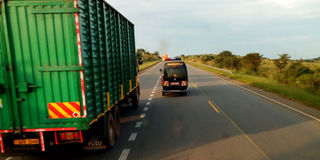What you need to know about climbing lanes

Climbing lanes are designed and created for use by heavy long trucks. Photo by Roland D. Nasasira
A climbing lane is an “extra” lane that is used for short distances in certain parts of the road to improve safety, ease congestion and prevent delays. Climbing lanes help reduce collisions and backups by providing slower moving trucks and vehicles an additional, safe lane to travel in. This reduces conflicts between slower moving trucks and passing vehicles.
Unlike in city centres or major towns, climbing lanes are most, if not all the time, found along major highways. However, what is important to note and understand is that they are not found on flat areas but at the start of driving up a hill.
Nicholus Mugabe, a regular motorist on the Masaka-Mbarara highway, says most Ugandan drivers do not understand the discipline or code of conduct of driving especially on climbing lanes.
“With a climbing lane, when I am driving fast and I am overtaking another car on a highway, I stay on the extreme left of the lane after overtaking so that I do not obstruct other fast road users from overtaking. Every vehicle and motorist drives on a different speed especially when they are driving up the hill,” Mugabe explains.
“What I have noticed is that after overtaking on a climbing lane, some motorists stay in the middle lane and deliberately refuse to drive to the extreme left hand side lane forgetting that there are or could be other fast motorists who could want to overtake them,” he adds.
A climbing lane that is usually at the start of the hill as you drive uphill has three lanes.
This means that in total, there are three lanes- two for vehicles going up the hill and one for those going downhill.
How they are designed
Charles Ssebambulidde, the traffic and road safety spokesperson, says on most highways in Uganda, climbing lanes are designed and created for use by heavy moving and long trucks. The speed for commercial or long trucks, Ssebambulidde reasons is in most cases slower compared to fast moving saloon or Sport Utility Vehicles (SUV) with capacity to overtake on a hill.
“As you drive towards the end of the climbing lane, the road sign will show or read that it is ending or it has ended to merge with the main lane. When you read this sign post, you are supposed to slow down or reduce your speed so that you do not cause head-on collision with on-coming traffic,” Ssebambulidde explains.
Safety on the climbing lane
According to Wikipedia, an online portal, the climbing lane effectively creates a bi-directional central passing lane of the original uphill running lane. Its subsequent risk of head-on collisions, they are sometimes referred to as “suicide lanes.”
In some cases to reduce the risk, the road will be signed to prohibit overtaking when going downhill.
Variations on this theme include altered road markings to highlight the climbing lane as being a temporary addition to the normal two (shorter dashed lines similar to those on merge/diverge lanes), or more clearly demarcating the two higher speed lanes.
For example, with markings that prevent uphill fast traffic using the downhill lane to pass slightly slower uphill vehicles themselves passing crawlers, but still allowing downhill vehicles to overtake using the faster uphill lane if necessary, which has the effect of creating a false center line between the two regular lanes.
A few more facts:
A climbing lane looks the same as any other lane and is the same width.
Climbing lanes usually are used on uphill segments of highway that have a steep grade (usually 5-6 percent grade).
Climbing lanes typically are marked with signage advising slower traffic to keep right.
Overtaking lane signage
These are some of the signs to watch out for when overtaking.
Overtaking lane ahead: These signs advise motorists of an upcoming overtaking lane. They increase road safety by allowing motorists to relax their search for an informal overtaking opportunity, knowing that a dedicated overtaking lane is approaching.
Keep left unless overtaking: A ‘Keep left unless overtaking’ sign requires all drivers, including drivers of slow moving vehicles, to keep in the left lane, allowing other vehicles to overtake them in the right lane. All vehicles must keep to the Left lane unless they are:
• Overtaking
• Making a right hand turn
• Avoiding an obstruction
• Driving in congested traffic
• Driving in a special purpose lane they are allowed to be in.
Left lane ends: ‘Left lane ends’ and ‘Merge right’ signs provide advance warning for drivers that traffic will need to merge with traffic in the continuing lane. You must also give way to any vehicle in the lane you are moving into. It may not be safe to overtake when you are in the left hand lane and you see these signs as your lane will be ending soon and you may not have enough space to overtake.
Source: www.signalindustries




